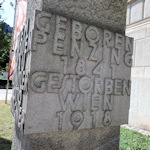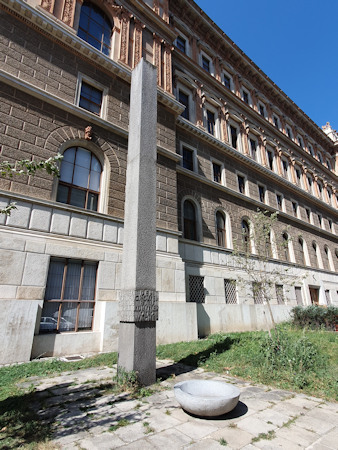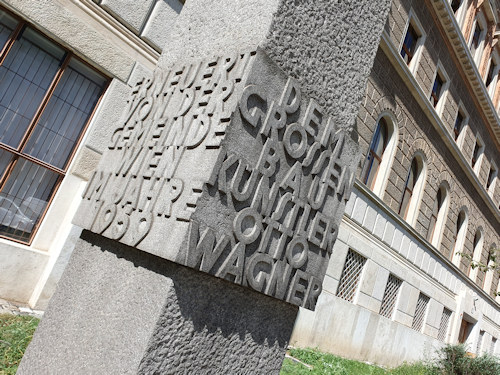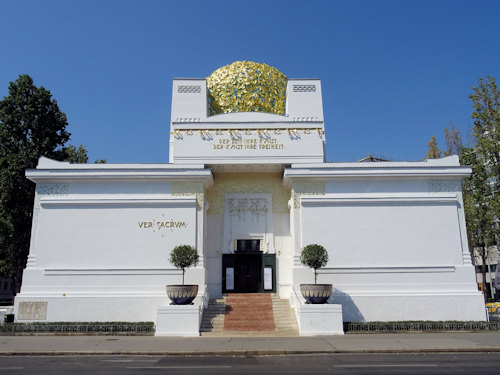
Anyone who changed the way people think about architecture with their pioneering vision deserves their own little piece of the cityscape in monument form. Which Otto Wagner got…sort of. Here’s the story.
- Monument put up in 1930 but soon removed
- Erected again in 1959 at a (far) less prominent location
- Original design by Josef Hoffmann
- Book a sightseeing tour* in Vienna
- See also:
One man. One column.

(Not going to lie: I’ve seen more impressive locations for monuments. And more impressive monuments, frankly, though it kind of fits Wagner’s philosophy)
So Vienna never ceases to surprise me. A city of contradictions, paradoxes and juxtapositions. A city proud of (much of) its history, but sometimes with an irrationally selective memory.
Consider the man widely regarded as a father of modern architecture: one Otto Wagner (1841-1918).
Wagner’s major and often groundbreaking architectural triumphs in Vienna include locations like the PSK building or the Steinhofkirche. Such monumental achievements would deserve, well, a monument, you might think.
And so it was, albeit with a short delay; Wagner’s passing coincided with the death of the Habsburg monarchy and the start of a period when the city had bigger issues to worry about than honouring a celebrated son.

(A closer look at the inscribed cubic relief)
A monument did make an appearance in late June, 1930, in the form of a triumphal column, erected by the Österreichischer Werkbund to a blueprint by the great architect and designer (and former Wagner student) Josef Hoffmann.
The Werkbund was a significant but relatively short-lived association that sought to bring together industry, art, crafts and architecture…a goal mirrored in its diverse membership.
Hoffmann came up with several designs, but the final form perhaps reflected Wagner’s own ethos best: a simple tall column made of granite with an inscribed cubic relief part of the way up.
The unveiling took place in the presence of the Austrian president with the column occupying a prominent place in the heart of Vienna on a corner of the famous Heldenplatz square.
So far so good.
Fast forward a few years and off the column went into storage, reportedly to free up space for a planned monument to the austrofascist chancellor Engelbert Dollfuß (a more contemporary theme in line with the unfortunate political thinking prevalent in the 1930s).
The monument stayed in storage until 1959 when it was put back…but not on Heldenplatz.
Instead, you find the Wagner column down one side of the prestigious Academy of Fine Arts Vienna (home to students, academics and some rather significant art).
The new location has a solid justification, given Wagner’s influential time teaching at the university. However, the position on the verge of a small side street limits its impact. Indeed, I found it mighty hard to even get a decent photo with my phone.

(The Secession building is a near neighbour)
You feel Wagner perhaps deserves better from the city he blessed with architectural beauty.
The inscriptions around the cubic relief read (my rough translation):
- “The Austrian Werkbund in the year 1930”
- “Born in Penzing 1841, died in Vienna 1918”
- “To the great architect Otto Wagner”
- “Restored by the municipality of Vienna in the year 1959”
That fourth inscription tells you the inscribed stone got a makeover before its reappearance (apparently made necessary following damage to the original).
How to get to the monument
Despite its tucked away location, the monument remains quite central and easily reached on foot or via public transport. It’s also close to the remarkable Secession building, home to Klimt’s Beethovenfries.
Subway: Karlsplatz station is nearby, on the U1, U2 and U4 lines. Look for exits on the western side of this large station.
Tram: The trams that travel around the Ring will get you there easily enough. For example, take the 1, D, 71 or 2 to Burgring or Oper/Karlsplatz. Then you have a short walk to the monument.
Address: Makartgasse 2, 1010 Vienna